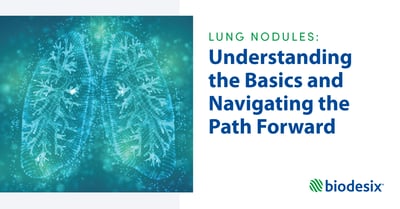The Nodify XL2™ blood test helps direct next steps in lung nodule management [Video]
TRANSCRIPT
DR. BOWLING: An incidental nodule is basically any kind of abnormal growth in the lung that’s found for reasons other than screening. These are patients that might come in to the Emergency Department and have chest pain and get a CT scan and we find a growth. The point is that we find it and then we identify those patients and try to determine what’s the risk of cancer and we can do that in various ways.
DR. BHADRA: As we have built out our thoracic oncology program in Chattanooga, we’ve noticed that it’s a collaborative effort, trying to figure out the most efficient way to move a patient through the system. When assessing a lung nodule, one of the important things, we don’t have a lot of tools in terms of determining whether that patient needs to be biopsied or not. So when we are looking at lung nodules we want to utilize all the tests that we have available and all the tools we can utilize to be able to assess whether a lung nodule needs to be biopsied or not. So rather than looking at a chart, or looking at the size of the lung nodule, or using a calculator, we can actually test the patient’s blood to see if it’s appropriate to do a biopsy, and that’s revolutionary.
DR. BOWLING: I think the Nodify XL2 test can potentially revolutionize how we manage indeterminate pulmonary nodules in the sense that it is going to give us another tool we can use in these patients that have indeterminate pulmonary nodules that are really on the smaller end of being able to biopsy accurately. There’s a large multi-center study that helped validate this test that looked at it’s use in patients who have indeterminate pulmonary nodules with the risk factor of 50% or less for having cancer.
DR. PRITCHETT: The test really helps us to stratify these large number of patients that come in with nodules and help us assess which nodules need an intervention sooner and which ones maybe can go into watchful waiting. Combining that pre-risk assessment of the Mayo Calculator with the proteomic assessment of that patient’s own blood, then we can really offer a next level risk stratification for this patient and hopefully rule out disease.
DR. BHADRA: And we can spare that patient a needless, invasive test, and that’s important.
DR. PRITCHETT: When we have some actual data that’s backed up by science that adds a significant level of confidence both for us and for those patients. It’s hard for us to understand what that’s like for patients to go home every night and wonder do I have cancer? So this adds a little bit of confidence for them. The promise that Nofify XL2 offers us is being able to do a blood test and potentially avoid unnecessary procedures in patients that may have benign disease.
Topics: lung nodule, video



